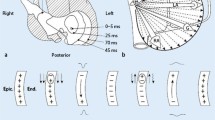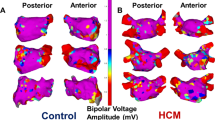Abstract
The Chiari network (CN) is a mobile, net-like structure occasionally present in the right atrium, near the opening of the inferior vena cava and coronary sinus. While typically asymptomatic, it may contribute to thromboembolism or right atrial pathologies. Here, we hypothesized that existing differences in P-wave morphology on electrocardiograms (ECG) may be associated with atrial conduction changes. Seventy-one children with a CN were recruited and matched to 60 healthy controls. P-wave duration, P-wave amplitude, P dispersion (Pd), QRS, PR, QT, and QTc (calculated with Bazett formula) intervals were measured and compared. Between the control and the patient groups, the mean P-wave duration was 78.1 ms and 88.7 ms, P amplitude was 1.3 mm and 1.1 mm, and Pd was 18.9 and 35.5 ms, respectively. These differences were statistically significant across all measurements (p < 0.05). Atrial conduction may be affected in patients with CN, and these patients may then develop atrial arrhythmia.
Similar content being viewed by others
Abbreviations
- AF:
-
Atrial fibrillation
- CN:
-
Chiari network
- ECG:
-
Electrocardiogram
- ECO:
-
Echocardiogram
- Pd:
-
P-wave dispersion
- SPSS:
-
Statistical package for social sciences
References
Chiari H (1897) Ueber Netzbildungen im rechten Vorhofedes Herzens. Beitr Pathol Anat 22:1–10
Islam AK, Sayami LA, Zamana S (2013) Chiari network: a case report and brief overview. J Saudi Heart Assoc 25(3):225–229
Schneider B, Hofmann T, Justen M, Meinertz T (1995) Chiari's network: normal anatomic variant or risk factor for arterial embolic events? J Am Coll Cardiol 26(1):203–210
Loukas M, Sullivan A, Tubbs RS, Weinhaus AJ, DerDerian T, Hanna M (2010) Chiari’s network: review of the literature. Surg Radiol Anat 32(10):895–901
Prajapat L, Ariyarajah V, Spodick DH (2007) Abnormal atrial depolarization associated with Chiari network? Cardiology 108:214–216
Chesi G, Farinelli F, Di Donato C, Marani L, Reverzani A (1989) Chiari’s network: persistence of the embryonic remnants of the valve of the sinus venosus in the right atrium Echocardiographic and clinical analysis in a group of subjects. Minerva Cardioangiol 37:333–339
Clements J, Sobotka-Plojhar M, Exalto N, van Geijn HP (1982) A connective tissue membrane in the right atrium (Chiari's network) as a cause of fetal cardiac arrhythmia. Am J Obstet Gynecol 142(6 Pt 1):709–712
Alegría-Barrero E, Alegría-Barrero A, Gavira Gómez JJ, Rábago J-A (2011) Chiari's network and paroxysmal atrial fibrillation. Rev Esp Cardiol 64(8):727–728
Geng HH, Li R, Su YM, Pan HY, Pan M, Ji XP (2014) A functional single-nucleotide polymorphism in interleukin-6 promoter is associated with p wave dispersion in hypertensive subjects with atrial fibrillation. Int J Clin Exp Med 7(11):4434–4440
Okutucu S, Aytemir K, Oto A (2016) P-wave dispersion: what we know till now? JRSM Cardiovasc Dis. https://doi.org/10.1177/2048004016639443
Dilaveris PE, Gialafos JE (2001) P-wave dispersion: a novel predictor of paroxysmal atrial fibrillation. Ann Noninvasive Electrocardiol 6:159–165
De Sisti A, Leclercq JF, Stiubei M, Fiorello P, Halimi F, Attuel P (2002) P wave duration and morphology predict atrial fibrillation recurrence in patients with sinus node dysfunction and atrial-based pacemaker. J Pacing Clin Electrophysiol 25(11):1546–1554
Perez-Riera AR, de Abreu LC, Barbosa-Barros R, Grindler J, Fernandes-Cardoso A, Baranchuk A (2016) P-wave dispersion: an update. Indian Pacing Electrophysiol J 16:126–133
Garson A (1998) Electrocardiography. In: Garson A, Bricker JT, Fisher DJ, Neish SR (eds) The science and practice of pediatric cardiology, vol 1, 2nd edn. Williams & Wilkins, Baltimore, pp 735–788
Willems JL, Robles de Medina EO, Bernard R, Coumel P, Fisch C, Krikler D et al (1985) Criteria for intraventricular conduction disturbances and pre-excitation. World Health Organizational/International Society and Federation for Cardiology Task Force Ad Hoc. J Am Coll Cardiol 5:1261–1275
Bayés de Luna A, Cladellas M, Oter R, Torner P, Guindo J, Martí V et al (1988) Interatrial conduction block and retrograde activation of the left atrium and paroxysmal supraventricular tachyarrhythmia. Eur Heart J 9(10):1112–1118
Ariyarajah V, Asad N, Tandar A, Spodick DH (2005) Interatrial block: pandemic prevalence, significance, and diagnosis. Chest 128:970–975
Ariyarajah V, Puri P, Apiyasawat S, Spodick DH (2007) Interatrial block: a novel risk factor for embolic stroke? Ann Noninvasive Electrocardiol 12(1):15–20
Köse S, Kiliç A, Iyisoy A, Kurşaklioğlu H, Lenk MK (2003) P wave duration and P dispersion in healthy children. Turk J Pediatr 45(2):133–135
Aytemir K, Ozer N, Atalar E, Sade E, Aksöyek S, Ovunc K et al (2000) P wave dispersion on 12-lead electrocardiography in patients with paroxysmal atrial fibrillation. Pacing Clin Electrophysiol 23(7):1109–1112
Irdem A, Aydın Sahin D, Kervancioglu M, Baspinar O, Sucu M, Keskin M et al (2016) Evaluation of P-wave dispersion, diastolic function, and atrial electromechanical conduction in pediatric patients with subclinical hypothyroidism. Echocardiography 33(9):1397–1401
Akpinar M, Ocal M, Irdem A (2019) Ventricular repolarization changes in children with breath holding spells. J Electrocardiol 55:116–119
Park JK, Park J, Uhm J, Joung B, Lee M, Pak H (2016) Low P-wave amplitude (<0.1 mV) in lead I is associated with displaced inter-atrial conduction and clinical recurrence of paroxysmal atrial fibrillation after radiofrequency catheter ablation. EP Europace 18(3):384–391
Acknowledgements
The authors would like to thank all the workers in Department of Pediatrics for their support.
Funding
Research is not funded by any grant.
Author information
Authors and Affiliations
Corresponding author
Ethics declarations
Conflict of interest
All authors have no conflicts of interest to declare.
Ethical Approval
All procedures performed in this study were in accordance with the ethical standards of the institutional and/or national research committee and with the 1964 Helsinki declaration and its later amendments or comparable ethical standards.
Informed Consent
Informed consent was obtained from a parent or legal guardian post review of consent document and after all questions were answered. Institutional review board approvals were obtained for this study.
Additional information
Publisher's Note
Springer Nature remains neutral with regard to jurisdictional claims in published maps and institutional affiliations.
Rights and permissions
About this article
Cite this article
Irdem, A., Akpinar, M., Celebi, E. et al. P-Wave Changes Associated with Chiari Network in the Right Atrium. Pediatr Cardiol 41, 1773–1776 (2020). https://doi.org/10.1007/s00246-020-02441-9
Received:
Accepted:
Published:
Issue Date:
DOI: https://doi.org/10.1007/s00246-020-02441-9




